Hanuman in Hindu Mythology: Origin Story, Worship, Powers, & Cultural Impact
Hanuman is a central and beloved figure in Hindu mythology, renowned for his unwavering devotion to Lord Rama and his superhuman feats as depicted in ancient texts, particularly the Ramayana. He is revered across several cultures in India and Southeast Asia, embodying the ideal devotee and a symbol of strength, loyalty, bravery, and righteousness.
Origins and Birth
Hanuman’s birth story is enchanting and miraculous, illustrating the divine circumstances surrounding his arrival. According to mythology, he is the son of Anjana, an apsara (celestial nymph) who was cursed to be born on earth as a female monkey. Anjana performed intense prayers to Lord Shiva to seek liberation from the curse, resulting in the birth of Hanuman.
In some accounts, Hanuman is also considered a partial incarnation of Lord Shiva, born with the blessings of the wind god, Vayu, who played a crucial role in his birth, which endowed Hanuman with incredible physical strength and mystical powers.
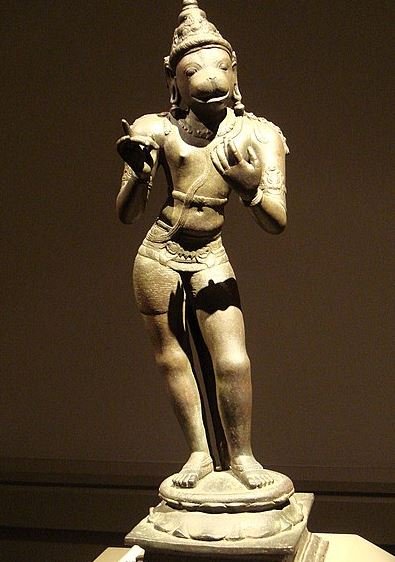
Hanuman, a central figure in Hindu mythology, commands the monkey army in the Ramayana. He is celebrated for his unwavering devotion to Rama and his heroic deeds throughout the epic. Image: Statue of Hanuman.
Early Life and Powers
From his infancy, Hanuman exhibited extraordinary capabilities and mischievous tendencies. One famous story recounts how he mistook the sun for a ripe fruit and leapt to swallow it, only to be struck down by Indra, the king of gods, and subsequently revived by the intervention of Vayu.
The above episode led to Hanuman being blessed with several divine boons by various gods, including immortality, immense strength, the ability to change his form at will, and protection from all weapons.
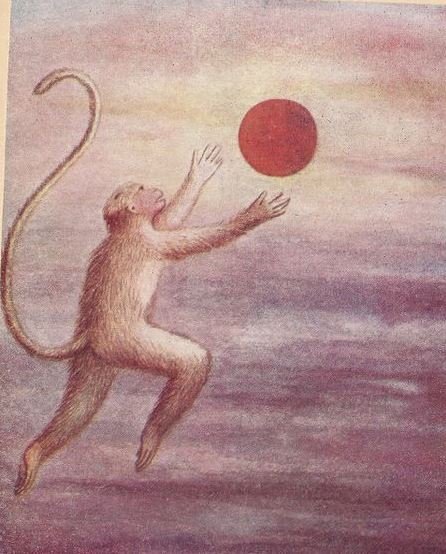
As a baby, Hanuman, born to a nymph and the wind god, mistook the Sun for a fruit and tried to grab it. Indra struck him, damaging his jaw (hanu), hence his name. Image: An illustration, by Indian artist BSP Pratinidhi, depicting young Hanuman aiming for the Sun.
Devotion to Rama
The core of Hanuman’s story revolves around his devotion to Lord Rama (aka Lord Ram), the seventh avatar of Vishnu.
His servitude and dedication are first seen when he meets Rama during Rama’s exile in the forest. Hanuman becomes a devout follower and an integral part of the quest to rescue Sita, Rama’s wife, who was kidnapped by the demon king Ravana.
Hanuman’s journey to Lanka, the kingdom of Ravana, showcases his devotion and courage. His leap across the ocean to reach Lanka is one of the most celebrated exploits in Hindu lore.
In Lanka, Hanuman’s adventures include burning down part of the city using his tail, which was set ablaze by Ravana’s forces, and delivering Rama’s ring to Sita as a sign of hope and assurance. This act alone depicts his resourcefulness and his pivotal role as a messenger and loyal servant.

Characterized by a red face and human-like posture, Hanuman symbolizes supreme devotion (bhakti) for his service to Rama.
The Ramayana and Beyond
Throughout the Ramayana, Hanuman’s role is that of a faithful aide and a strategic warrior. His chants, prayers, and discussions are often infused with teachings about devotion, dharma (duty/righteousness), and the power of true faith.
After the defeat of Ravana, Hanuman continues to serve Rama and plays a crucial role in Rama’s coronation and the subsequent events in Ayodhya.
Beyond the Ramayana, various other texts, such as the Mahabharata and several Puranas, also mention Hanuman, portraying him as a figure of unwavering righteousness who even assists other avatars of Vishnu, including Krishna.
In some versions of the Mahabharata, he is also shown to be present on the battlefield of Kurukshetra, providing moral support to the Pandavas.
Worship and Symbolism
Hanuman is widely worshipped as a deity in his own right, especially in India. Temples dedicated to Hanuman are found in almost every village and town across the country. His image, often colored red or deep saffron, depicts him as either a robust monkey-faced figure with a mighty physique or as a scholarly figure, embodying both strength and intellect.
Tuesdays and Saturdays are particularly associated with Hanuman worship, and offerings of sweets, flowers, and the chanting of the Hanuman Chalisa—a 40-verse hymn in praise of him—are common practices aimed at seeking his protection and blessings.
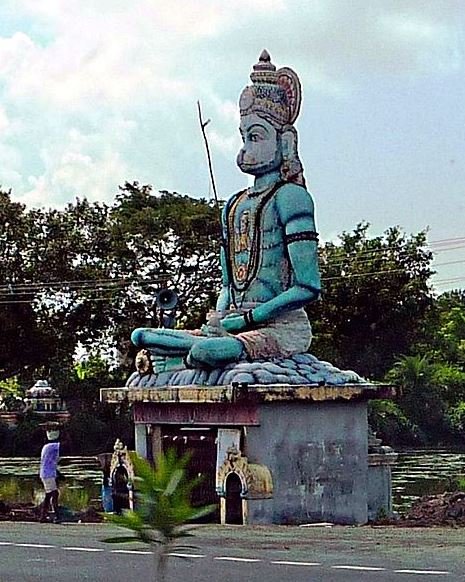
Hanuman is a pivotal figure in Hindu worship, often depicted in temples dedicated to Rama or in shrines specifically for him, which are frequented by monkeys that are treated with respect. Image: Hanuman shrine in the Indian state of Tamil Nadu.
Did you know…?
- The film “Monkey Man” (2024), inspired by Hanuman’s legend, features Dev Patel’s character channeling the deity’s loyalty and devotion as he seeks revenge for his mother’s death, embodying the enduring qualities of the mythological hero. The film, which was Patel’s directorial debut, premiered on SXSW (South by Southwest) on March 11, 2024. The film stars Patel, Pitobash Tripathy, Sharlto Copley, Adithi Kalkunte, Vipin Sharma, and Zakir Hussain.
- The Hanuman langur, a common Indian monkey, bears his name, underlining his significant cultural and religious stature.

Cultural Impact
Hanuman’s impact extends beyond religious boundaries. He is a cultural icon in various forms of art, drama, music, and dance across Asia. His story has been retold through countless generations, each adding their own cultural elements to the narrative.
In Southeast Asia, versions of the Ramayana incorporate Hanuman in a manner that reflects local traditions and values, emphasizing his significance as a bridge between diverse cultures and communities.

Hanuman’s tales are not only lessons of morality and devotion but also reflect the deep spiritual and cultural ethos of Hindu tradition.
Frequently asked questions about the Monkey Man

Hanuman is a divine monkey god known for his strength, loyalty, and devotion to Lord Rama. He is a central figure in the Hindu epic Ramayana. Image: Rama depicted carrying bows and arrow.
What are the origins of Hanuman?
Hanuman is the son of Anjana, an apsara transformed into a monkey due to a curse, and Kesari, a monkey chief. He is also considered a manifestation of the wind god, Vayu.
Why is Hanuman so significant in the Ramayana?
Hanuman plays a crucial role in the Ramayana, notably in the search for Sita, Rama’s wife, who was abducted by Ravana. His devotion and bravery in the mission to save Sita highlight his importance.

What are some of Hanuman’s supernatural abilities?
Hanuman had several divine powers, including the ability to change size, fly, and possess incredible strength. These were gifts bestowed upon him by various deities.
How is Hanuman worshipped?
His reverence extends beyond India; Hanuman is also celebrated in Buddhist traditions across Central, Southeast, and East Asia, where numerous temples stand in his honor and regions are named after him. However, narratives vary significantly outside India; unlike the celibate hero of the Sanskrit epics, he is sometimes portrayed with wives and children.
For Indo-Caribbean communities, the stories of Hanuman and Rama resonate deeply. Displaced from India and relocated to the Caribbean, these communities relate to Rama’s exile and Hanuman’s unwavering devotion, seeing Hanuman as the ultimate devotee. Some scholars note that because Hanuman embodies the dualities of peace and ferocity he, in a way, mirrors the Indo-Caribbean experience of maintaining Hinduism as a minority religion amidst colonialism.
Annually, Indo-Caribbean families conduct Hanuman pujas, praying for prosperity and health, and erect a red flag to signify Hanuman’s blessings on their homes and land.
What is the Hanuman Chalisa?
The Hanuman Chalisa is a 40-verse hymn written by Tulsidas that praises Hanuman’s strength and devotion. It is a popular prayer recited by millions of Hindus every day.
Can Hanuman be found in texts other than the Ramayana?
Yes, Hanuman also appears in other ancient texts, including the Mahabharata and various Puranas, where he is depicted assisting other divine figures and engaging in different heroic acts.
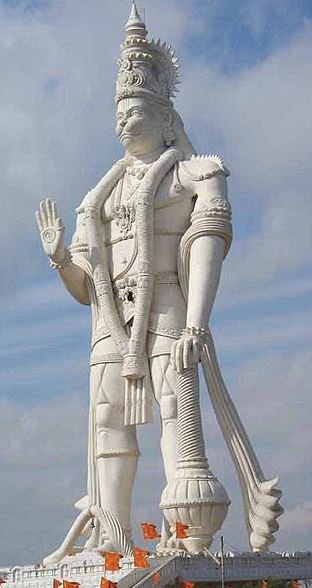
Hanuman remains a figure of veneration and admiration, inspiring millions to strive for courage in adversity and unyielding devotion in their spiritual pursuits. Image: A monument of Hanuman in the Indian state of Andhra Pradesh.
What does Hanuman symbolize?
Hanuman symbolizes devotion, strength, courage, and the faithful, selfless service. He is considered a model of devotion for his unconditional loyalty to Lord Rama.

Are there any special festivals associated with Hanuman?
Hanuman Jayanti is a major festival celebrated to commemorate the birth of Hanuman. It involves special prayers, processions, and various religious ceremonies in his honor.
How does Hanuman influence Indian culture?
Beyond religious practices, Hanuman influences Indian culture through literature, arts, and performances. His character is celebrated in various regional folk theatre, dances, songs, and visual arts, demonstrating his enduring appeal.
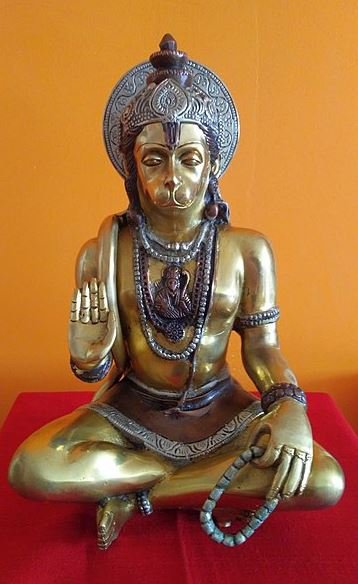
Hanuman’s influence permeates literature, inspiring the monkey hero of the Chinese epic “Journey to the West.” In India, he resonates with modern cultural and political narratives, idolized by the Rashtriya Swayamsevak Sangh and featured as a superhero in comic books. Image: Hanuman murti.
























